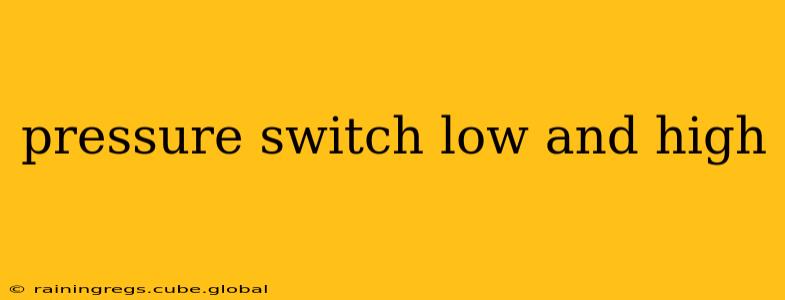Pressure switches are crucial components in various systems, from water pumps to air compressors, ensuring safe and efficient operation by controlling the activation and deactivation of equipment based on pressure levels. Understanding how these switches work, particularly their low and high pressure settings, is key to maintaining optimal system performance and preventing damage. This comprehensive guide delves into the intricacies of pressure switches, explaining their functionality, troubleshooting common issues, and providing valuable insights into optimizing their performance.
What is a Pressure Switch?
A pressure switch is an electromechanical device that activates or deactivates an electrical circuit based on the pressure within a system. It essentially acts as a pressure-sensitive on/off switch. When the pressure reaches a predetermined high-pressure setpoint, the switch opens, turning off the system. Conversely, when the pressure drops to a predetermined low-pressure setpoint, the switch closes, restarting the system. This cycle ensures the system operates within a safe and efficient pressure range.
How Does a Pressure Switch Work?
Most pressure switches utilize a diaphragm or bellows connected to a set of electrical contacts. As pressure increases, the diaphragm or bellows flexes, causing the contacts to open or close. The precise mechanics vary depending on the switch design and application, but the fundamental principle remains the same: pressure change triggers a change in the electrical state.
Understanding High and Low Pressure Settings
The core functionality of a pressure switch revolves around its high and low-pressure settings. These settings define the operational pressure range of the system:
- High Pressure Cut-off: This setting determines the maximum pressure the system will reach before the pressure switch shuts off the equipment. Exceeding this pressure can lead to system damage or safety hazards.
- Low Pressure Cut-in: This setting determines the minimum pressure at which the pressure switch will restart the equipment. The system will remain inactive until the pressure drops to this level.
The difference between these two settings is known as the pressure differential or pressure range. This range is crucial because it dictates how frequently the system cycles on and off.
What are the Common Causes of Pressure Switch Problems?
Several factors can lead to pressure switch malfunctions. Let's delve into common issues:
1. Incorrect High and Low Pressure Settings:
Improperly adjusted high and low pressure settings are among the most common problems. Setting the high pressure too low could lead to premature shutdowns, while setting it too high increases the risk of system damage. Similarly, setting the low pressure too high results in infrequent cycling and potential system inefficiencies.
2. Faulty Pressure Switch:
Over time, a pressure switch's internal components can wear out or become damaged, leading to inaccurate readings or complete failure. This could involve issues with the diaphragm, contacts, or the internal mechanism.
3. Clogged Lines or Filters:
Restricted flow due to clogged lines or filters can prevent the pressure switch from accurately sensing the system's pressure, leading to erroneous shutdowns or delayed restarts.
4. Leaks in the System:
Leaks in the system can cause the pressure to drop rapidly, leading to frequent cycling or an inability to maintain the desired pressure. This puts extra strain on the pressure switch and other system components.
How to Adjust Pressure Switch Settings?
Adjusting pressure switch settings requires caution and depends on the specific switch's design. Refer to the manufacturer's instructions before attempting any adjustments. Generally, adjustments are made using adjusting screws located on the switch itself. These screws typically allow for fine-tuning of both the high and low pressure settings. Always turn the equipment off before making adjustments.
How Often Should I Check My Pressure Switch?
The frequency of pressure switch inspection depends on the application and the system's criticality. For critical applications, regular maintenance and inspection, including pressure testing, are essential. As a general guideline, it is recommended to check your pressure switch at least annually or more frequently if you notice inconsistent operation or performance issues.
What are the Signs of a Bad Pressure Switch?
Several signs can indicate a malfunctioning pressure switch. These include:
- Frequent cycling: The equipment turns on and off repeatedly in short intervals.
- Equipment not turning on: The equipment fails to activate even when the pressure is below the low-pressure setpoint.
- Equipment not turning off: The equipment continues to run even when the pressure has reached or exceeded the high-pressure setpoint.
- Inconsistent operation: The equipment's operation becomes erratic and unpredictable.
This detailed guide offers a comprehensive understanding of pressure switches, covering their functionality, troubleshooting, and maintenance. Remember to always consult the manufacturer's instructions for your specific pressure switch model. Proper understanding and maintenance are vital for ensuring the safe and efficient operation of your system.
